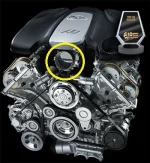Technically, I think you are correct. But in a fuel injected engine with drive by wire, I don't think that the throttle plate would get any fuel injector cleaner that was put in the gas tank, so I am not sure if it is relevant. Also, I don't think it is subject to gumming up to anywhere near the same degree as if the throttle plate was in the carburetor.
Here is an explanation I found on Wikipedia (I believe the Genesis has "drive by wire," but not 100% sure):
In fuel injected engines, the throttle body is the part of the air intake system that controls the amount of air flowing into the engine, in response to driver accelerator pedal input in the main. The throttle body is usually located between the air filter box and the intake manifold, and it is usually attached to, or near, the mass airflow sensor.
The largest piece inside the throttle body is the throttle plate, which is a butterfly valve that regulates the airflow.
On many cars, the accelerator pedal motion is communicated via the throttle cable, to activate the throttle linkages, which move the throttle plate. In cars with electronic throttle control (also known as "drive-by-wire"), an electric motor controls the throttle linkages and the accelerator pedal connects not to the throttle body, but to a sensor, which sends the pedal position to the Engine Control Unit (ECU). The ECU determines the throttle opening based on accelerator pedal position and inputs from other engine sensors.








